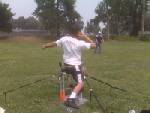Between the November and December Training Camps, Sam lifted heavy weights, with 330 pounds being his heaviest. After the December camp he reduced the maximum weight to around 200lbs and added swimming to his routine. He concentrated on stretching and speed and agility in his throwing practice.
With his coach joining him in San Diego two days into the December camp, Sam needed to maneuver his field chair with his suitcase (balanced on the forks he had mounted on the front of his chair) from Baggage, up and over the sky bridge and down to the waiting Olympic Training Center van. During this camp he continued to improve his ability to keep up with the team’s grueling schedule. He now sets multiple alarms on his watch so he doesn’t lose track of time in the morning and reports to breakfast and his events on time.
Sam returned from the December camp with more official clothing and instructions to wear only Nike or plain shirts and shorts when training as they are the official sponsors of the US Paralympics. He also received an official team backpack, wheelchair bag and duffel, all bearing the winged “USA” and “USA Track and Field” logos.
In the last couple of weeks, many communications have come from the head coach and organization staff. Sam was instructed to check his email at least once a day. Here is an excerpt from one email:
“PREPARING for a COMPETITION
1) Know your travel details—when the plane departs and arrives, how you will get to the hotel, what hotel you are staying at, how you are travelling to the venue to compete.
2) Know the meet schedule—what day and time will you compete— what type of a schedule is it (rolling or time established). Write up your personal schedule when you need to leave the hotel, how long of warm-up you will need, when you need to check in with the clerk of the course, where the clerk of the course’s table is and how far the warm-up area is from the track. If there is not a warm-up area that fits your needs, be sure to find a location the day prior, if possible where you can properly warm-up.
It is always better to be there 40 minutes early and scope out everything than be 20 minutes late and be in a panic or miss your event.
3) What should be in your backpack?– That depends on your classification and events.
- EVERYBODY – Credential — Water and/or Powerade, Snack (Fruit, PowerBar, granola bar), a small towel, extra safety pins, toilet paper (small little packet of T.P.), a small plastic bag to keep gear dry if it’s raining, have a list of all medications (correctly spelled) that you are taking—just in case you are drug tested, sunscreen, a sweatshirt or rain jacket and a little cash. A watch that is on meet time. Wheelchair athletes put your names on the hub of your wheel and on your chair—it makes it easier for others to put chairs together correctly.
- Throwers- Tools to tighten chairs, duct tape, white tape, have your name on your chair, one implement that you know has weighed-in, gloves if you use them, stakes, straps and hammer (depends on competition).
4) Testing the facility—Arrive early enough to check out the surfaces that you will be competing on– is the track soft, the ring slick, or the board flat—so you can prepare mentally for your competition. Check out the blocks prior to getting in them—see if the same type are in the warm-up area and make sure you know how they adjust. Know where the medical staff will be located.
5) Know the rules of your event—Have a copy of the rules for your event in your bag.
6) Lay-out your uniform and bag the night before—make sure you have your uniform, socks, shoes and everything you will need the next day. Inspect all your equipment. If you have your competition number, put it on your uniform the night before. Remember to put your credential in your bag. Check your bag each night before a competition to make sure you have everything. If you’re missing something, you have time to try to replace it, rather than trying to find it when you are at the track.
Hopefully, following these tips will allow you to sleep comfortably the night before and not worry about forgetting something.”
January 6 is here and his bag is packed and by the door. His competition uniform, along with an envelope with a copy of his passport and all his travel information are in the backpack . There is also a copy of the passport and travel documents in his checked bag. The shot put and discus weigh his suitcase down a bit but luckily the coaches will be carrying the straps and spikes used to tie down the throwing chair. (This photo is taped to Sam’s throwing chair so the officials will know how to tie it down)
The plane leaves at 10:30 this evening and arrives Saturday. The flight is 14 hours and crosses the International Date Line. On such a long flight, everyone has been instructed to stretch and move their legs often during the flight.
Be sure to check out the US Paralympic web site. Sam’s picture and profile are on the Athlete page: http://usparalympics.org/athletes/samuel-craven



